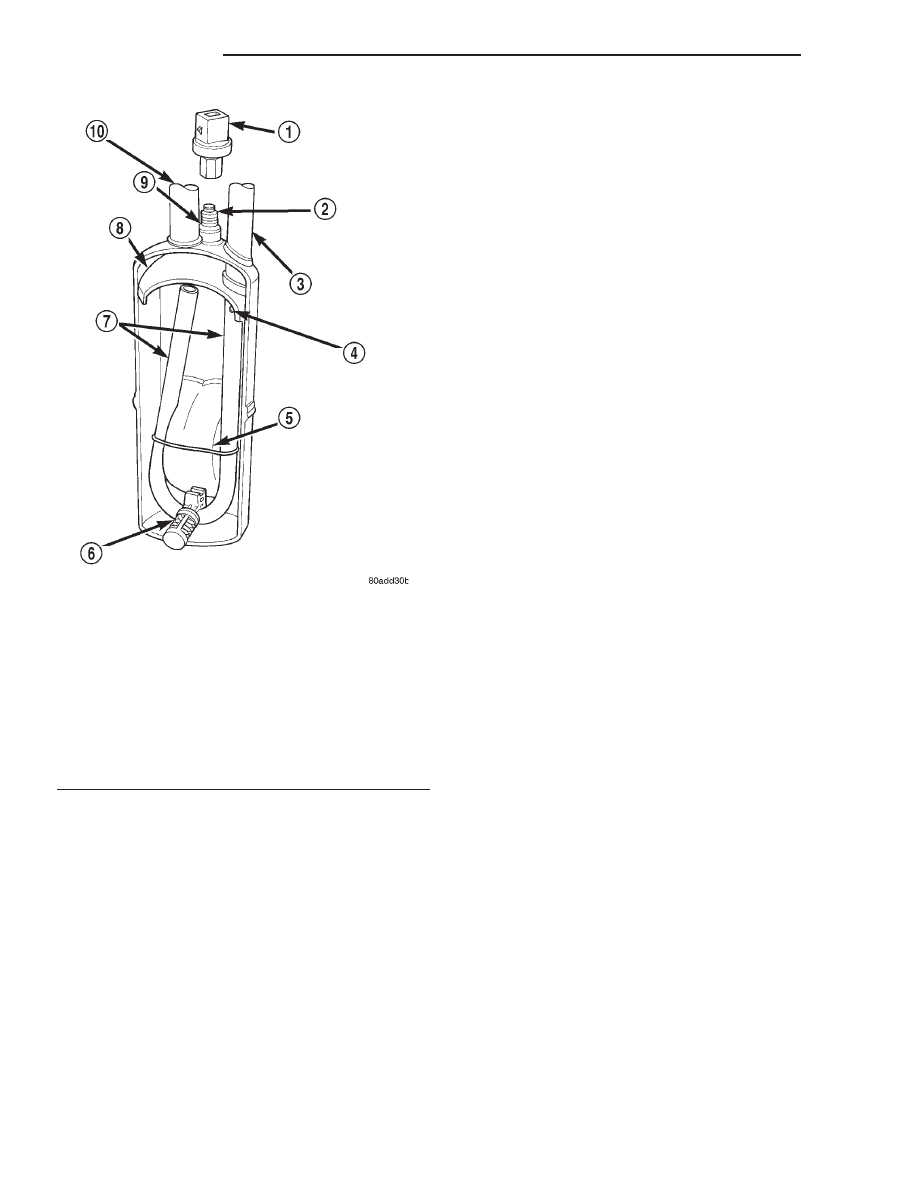Dodge Dakota (R1). Manual - part 799

(4) If the vehicle is so equipped, remove the nuts
that secure the vehicle speed control servo mounting
bracket to the studs on the cowl plenum panel and
move the servo far enough to access the accumulator
refrigerant line couplers (Refer to 8 - ELECTRICAL/
SPEED CONTROL/SERVO - REMOVAL).
(5) Loosen the screw that secures the accumulator
retaining band to the support bracket on the dash
panel.
(6) Disconnect the suction line refrigerant line fas-
tener from the accumulator. Install plugs in, or tape
over all of the opened refrigerant line fittings.
(7) Disconnect the accumulator inlet tube refriger-
ant line secondary clip from the accumulator. Install
plugs in, or tape over all of the opened refrigerant
line fittings.
(8) Pull the accumulator and retaining band unit
forward until the screw in the band is clear of the
slotted hole in the support bracket on the dash panel.
(9) Remove the accumulator from the vehicle.
INSTALLATION
WARNING: (Refer to 24 - HEATING & AIR CONDI-
TIONING/PLUMBING - WARNING) AND (Refer to 24 -
HEATING & AIR CONDITIONING/PLUMBING - CAU-
TION) BEFORE PERFORMING THE FOLLOWING
OPERATION.
(1) Install the accumulator and retaining band as
a unit by sliding the screw in the band into the slot-
ted hole in the support bracket on the dash panel.
(2) Remove the tape or plugs from the refrigerant
line fittings on the accumulator inlet tube and the
evaporator outlet tube. Connect both refrigerant lines
to the accumulator. Tighten the fasteners to 25.99
±3.39 N·m (230 ±30 in. lbs.).
(3) Tighten the accumulator retaining band screw
to 4.5 N·m (40 in. lbs.).
(4) Plug the wire harness connector into the low
pressure cycling clutch switch.
(5) Connect the battery negative cable.
(6) Evacuate the refrigerant system. See Refriger-
ant System Evacuate in the Service Procedures sec-
tion of this group.
(7) Charge the refrigerant system. See Refrigerant
System Charge in the Service Procedures section of
this group.
NOTE: If the accumulator is replaced, add 120 mil-
liliters (4 fluid ounces) of refrigerant oil to the
refrigerant system. Use only refrigerant oil of the
type recommended for the compressor in the vehi-
cle.
HEATER CORE
DESCRIPTION
The heater core is located in the HVAC housing,
under the instrument panel. It is a heat exchanger
made of rows of tubes and fins.
The heater core is not repairable and if damaged it
must be replaced.
OPERATION
Engine coolant is circulated through heater hoses
to the heater core at all times. As the coolant flows
through the heater core, heat removed from the
engine is transferred to the heater core fins and
tubes. Air directed through the heater core picks up
the heat from the heater core fins. The blend door
Fig. 6 ACCUMULATOR - TYPICAL
1 - A/C LOSS OF CHARGE SWITCH
2 - LOSS OF CHARGE SWITCH FITTING
3 - OUTLET TO COMPRESSOR
4 - ANTI-SIPHON HOLE
5 - DESICCANT BAG
6 - OIL RETURN ORIFICE FILTER
7 - VAPOR RETURN TUBE
8 - ACCUMULATOR DOME
9 - O-RING SEAL
10 - INLET FROM EVAPORATOR
24 - 42
PLUMBING
AN
ACCUMULATOR (Continued)